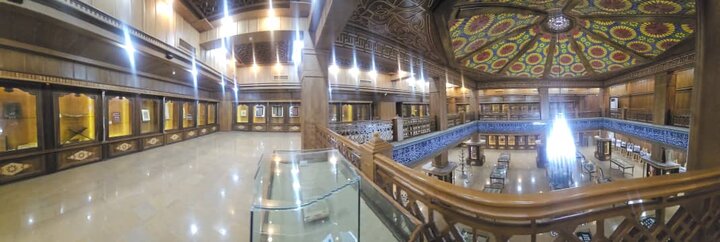Loan exhibit of Islamic arts underway at Shiraz museum

TEHRAN - As part of the 3rd International Multimedia Festival of Cultural Heritage, the exhibition “Reflections of Islamic Art in Iran” was inaugurated at the Museum of the Holy Shrine of Shah Cheragh in Shiraz.
This exhibit features a selection of works from the Islamic period housed in the National Museum of Iran, including 70 pieces from the early centuries of Islamic era (Samanids) to the end of the Qajar period.
Pottery, tile work, metalwork, textile weaving, marquetry, calligraphy, painting, book decoration, architectural decorations, and more showcase the diversity and variety of this exhibition.
Among the displayed items are embroidered silk fabrics from Isfahan from the golden age of the Safavid period, a ceremonial garment embellished with divine verses from the Zand period, and works from the Golestan Palace related to the Qajar era, forming a collection that represents the art of Iran during the Islamic period on display at the Museum of the Holy Shrine of Shah Cheragh.

Blue and white porcelain with eye-catching nature-inspired motifs, reflecting Iran’s extensive trade with the Far East, especially China, during the revival of the Silk Road in the time of Shah Abbas the Great, adorned with the endowment seal “The servant of Shah Abbas endowed this to the shrine of Shah Safi,” silk fabrics from the royal workshops of Shah Abbas, exquisite copies of the Quran, a copy of “Masnavi” by the Iranian poet and mystic Jalal al-Din Muhammad Balkhi, documents related to the shrine of Sheikh Safi al-Din Ardabili, written in Persian and Arabic and bearing the seals of witnesses and judges, which are considered important administrative and judicial documents of this period.
Other notable items include tile work and gilded pottery inscribed with verses from Persian poets, and masterpieces of metalwork from this era.
The exhibited works come from Nishapur and Rabat Sharaf from Greater Khorasan, Gorgan (Jorjan), Amol from ancient Tabarestan, as well as archaeological sites in Rey, Kashan, Saveh, and Sultanabad in Central Iran, Ghabira in Kerman, unique works from the shrine of Sheikh Safi al-Din Ardabili, Soltaniyeh, and the UNESCO World Heritage site of Takht-e Soleiman from northwestern Iran, along with items from the Islamic period of Susa.
The National Museum of Iran, in line with its educational, research, and outreach objectives, as well as its interaction and collaboration with other museums, has been proactive in organizing joint exhibitions, of which the current exhibition is a testament.
AM
